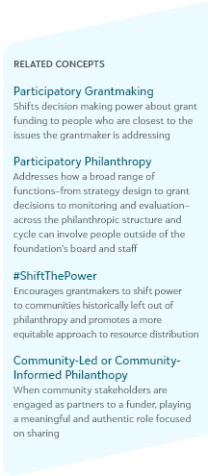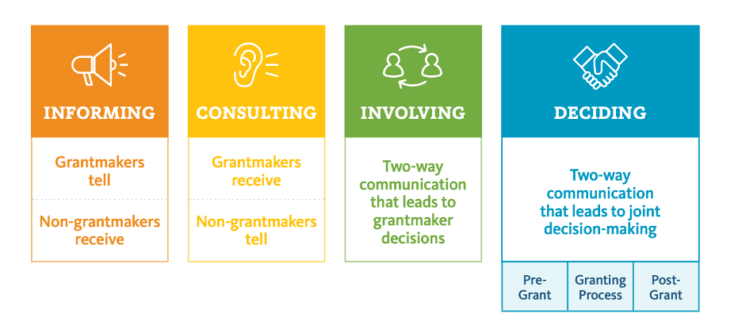Grantmaking: What’s Participation Got to Do with It?

In philanthropy, unlike democracy, there is often no way for people to participate–to share what they think or to influence decisions. People impacted by the grants typically have no say in who gets the funding, for what, how much, and for how long. Those at the top decide. In recent years, that model is being challenged. Lots of grantmakers are intrigued by participatory grantmaking. But what is it?
Deciding Together: Shifting Power and Resources Through Participatory Grantmaking offers this definition: “Participatory grantmaking cedes decision-making power about funding–including the strategy and criteria behind those decisions–to the very communities that funders seek to serve.”
What matters most in this model are values–and one in particular: equity. Participatory grantmaking invites to decision-making tables people who have historically been excluded. Participation aligns to human rights and social justice approaches. It can perhaps best be described by the slogan of the global disability rights movement: “nothing about us without us.”
Why Would a Grantmaker Choose a Participatory Grantmaking Approach?
It’s not easy to let go of power, and it’s not something most humans or institutions do naturally. And yet there are many reasons grantmakers decide to do it. Here are a few:

More Effective Decisions: It makes sense to involve the people impacted by philanthropic dollars in setting strategy and making grants! Who knows better than the people who are living the issues what will work best to address them? People at the heart of issues know the histories, the networks, the actors, the previous failures, and more.
A More Equitable Perspective: This kind of philanthropy is more just because communities have agency over decisions that affect their lives.
Stronger Relationships: Grantmakers can experience more trust and credibility between them and the communities they serve and an increased understanding, as well as the ability to take new risks. Participants can benefit from leadership development, knowledge sharing, network building, collaborations or partnerships, and/or compensation.
So, what does participatory grantmaking look like in practice? Donors, Boards of directors or trustees, and staff at foundations are letting go of some of the power to make decisions about grantmaking strategy and grants. But it doesn’t look the same for every organization and for every stakeholder. Participation can be understood as a spectrum that starts with informing (with no participation beyond the grantmaker) and moves to the community deciding, or jointly deciding with the grantmakers.

How Did Participatory Grantmaking Start?
As many have observed, participatory funding models have likely existed for centuries in the form of mutual aid or community support. In U.S. organized philanthropy, they’ve been present since at least the 1970s when the Funding Exchange Network members embraced these models. Grantmakers like the Fund for Southern Communities and Seeding Justice have long demonstrated commitments to shifting power through their participatory grantmaking. Since the 2000s, we’ve seen an increasing number of foundations embrace these practices, including at a national, regional and global level, including Diverse City Fund, Maine Initiatives, Solutions Project, Fund for Global Human Rights, Red Umbrella Fund, Equality Fund, Global Resilience Fund, With and For Girls Collective, and many more.
How Is Participatory Grantmaking Done?
In this kind of grantmaking, we often see people who are historically excluded from philanthropic decisions joining the process. Among organizations listed above, as well as other participatory grantmakers, there is a wide diversity of models and approaches being used. Kelly Buhles outlines some of the ways to structure participation in her article, “A Primer for Participatory Grantmaking,” and divides them into two main groupings: participatory committees and collective groups. Committees tend to be smaller groups of selected representatives who review and decide on grants. Collective groups may include all applicants for a particular funding stream or a larger public group. As she and others have written about, decision-making within these various structures can also be built in a variety of ways, from consensus to voting.
What these models all have in common is inviting people impacted by funding into the grantmaking process and shifting the power of decision-making to them. This means that staff—as well as those with wealth—move back to listen and implement the ideas and knowledge brought into the room by these participants. For staff, this often involves careful planning and facilitation, and playing a backend organizing role to ensure participants are easily able to engage in the tasks at hand.
Foundations that are taking a participatory grantmaking approach typically also have:
- Transparent processes to identify and select a diverse group of participants, with consideration of those historically most impacted and excluded
- Clearly defined roles, requirements, and benefits, as well as term expectations for all participants
- Fair and just compensation for and appreciation of participant time
- Inclusive and accessible practices for equitable participation in activities
- The ability to share accessible information about grant funding and its aims
- Ample time and support for review of materials as well as group discussion and debate
- Good preparation and facilitation at group meetings, including ‘ground rules,’ a commitment to surfacing disagreements, an awareness about power dynamics, and a clear process and tools for decision-making.
Who Else Is Doing Participatory Grantmaking?
We are excited to see increasing participation of people impacted by funding also being embraced in funder collaboratives like Fund for Shared Insight and the Health and Environment Funding Network. It is happening in family and private or institutional foundations like the Kataly Foundation’s Environmental Justice Resourcing Collective, too.
Newer, emerging grantmakers like Numun Fund and Transforming Power Fund are participatory from the beginning. Others like Mama Cash are shifting entire grantmaking programs to participatory practice. We are hopeful that we are near a tipping point where the more conventional top-down grantmaking is being challenged in favor of participatory approaches. Our view is that the bigger the resources and grants, the more community input or control is needed!
Getting Started with Participatory Grantmaking
First, we encourage you to consider whether you have the time, resources, and support to try out participatory processes–whether as a pilot, through a funder collaboration, or as a wholesale transition. Sometimes grantmakers decide the risk of doing harm is too great, or the burden of creating a good experience for participants is too high, and they fund an intermediary doing participatory grantmaking instead. We know participation is not easy to embrace, because this approach is ultimately about changing culture to embrace iteration and continuous learning. Still, when done well, the experience can be transformational. Just ask some of the organizations who have done it.
Second, we encourage you to review the Grantcraft Guide, Deciding Together: Shifting Power and Resources Through Participatory Grantmaking. This guide offers more information about the history of the practice and shares examples of how grantmakers do this work, with some useful tools. The Participatory Grantmaker community of practice is open to all eager to learn about participation in a peer-to-peer support network. Finally, to further consider power shifting, Philanthropy NW explores how participatory grantmaking can advance racial equity.
If you would like to learn more about participatory grantmaking, please check out our webinar, What’s All the Fuss About Participatory Grantmaking? Making Sense of This Evolving Practice. We’ll cover additional key components and best practices as well as common misconceptions about this approach to grantmaking.



